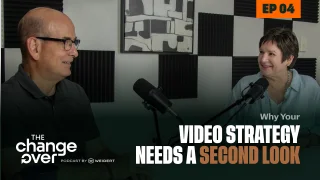Buyer Intent Data: What It Is, Why It’s Important & How to Use It
Written by
Two inbound marketing growth strategies that continue to gain momentum are account-based marketing (ABM) campaigns and paid ads (pay-per-click (PPC) ads).
With both executions, you’re maximizing marketing and sales efforts by focusing on the smallest possible target, even individual targets or target accounts.
Intent data can be a key to the effectiveness of your efforts. Intent data sheds light on the type of content that interests your target audiences so you can create more content of that type.
After all, when you know who is searching for content similar to your solution, you can personalize your messaging and reach them instead of reaching out to people who aren’t interested in your solution.
To truly understand how to maximize the use of intent data, we called upon an expert. Sumner Vanderhoof, CEO at Propensity, an ABM platform for small B2B growth teams looking to set up intent-based ABM campaigns.
We’ll get her insight in a minute. First, let’s cover the basics of intent data and why it’s so important.
What is Buyer Intent Data?
When you know what your target audiences prefer, what they need, and what they’re searching for … well, that’s power. Buyer intent data helps us marketers uncover all of that, putting power in our hands.
Where does buyer intent data come from? Massive amounts of data. From a huge field of information, intent signals — indicators that identify the topics audiences are engaging with — are harvested.
Now, you can create in-market accounts, the people you know are active in the marketplace, wanting to buy a certain solution. Their number of searches, their engagement, and their interactions with a source of a specific solution show their intent. Your in-market accounts (driven by B2B buyer intent data) now see you before they see your competitors.
How is Buyer Intent Data Made Actionable?
Data on its own is useless. You need to act on buyer intent data (the people currently looking for your solution) by showing them appropriate messaging.
Making data actionable starts by enriching millions of intent signals with details about your target audiences, which you may refer to as ideal customer profiles (ICPs) or buyer personas. To help you develop targeted content to reach these customers, demographics and behaviors are considered:
- Name
- Title
- Phone
- Skills and interests
- Social handles for target social ads
- Intent signals they’re trending on
Simply put into an equation: intent data signals + huge database = pinpointing niche targets actively searching for your solution. This extends your pool of potential customers and makes a conversation much easier to initiate.
Of course, your plan still requires KPIs, to help determine future decisions, and goals that need to be achieved.
Expert Assistance Goes a Long Way
We connected with an expert in buyer intent data, Sumner Vanderhoof, CEO at Propensity, a platform focused on helping businesses execute intent-powered marketing.
Our Q&A emphasizes using intent data for ABM campaigns, yet strategies can be used just as effectively for PPC ads (as you’ll see later):
Weidert Group: How do B2B marketers benefit most from implementing an ABM platform?
Sumner: With the overall goal of using intent data to automate ABM campaigns, we help with everything from strategy and planning to execution and analysis. Propensity offers ongoing support and analysis to ensure campaigns follow best practices and meet customer expectations.
WG: Let’s dig deeper. What tasks does an ABM platform expert perform that B2B marketers can’t?
Sumner: Each ABM campaign is unique, so a Propensity specialist assists with:
- Helping to identify best-fit target accounts
- Developing the messaging and content
- Launching the campaigns
- Measuring each campaign’s success
WG: Google, Facebook, LinkedIn, and other platforms have targeting filters; how is Propensity different?
Sumner: Linkedin applies targeting filters based on skills, seniority, industry, etc. But, these accounts are not necessarily trending with intent data specific to your offering. Facebook builds audiences based on trending interests, themes, and demographic details. Again, the audience built has contacts that are not necessarily trending with intent data specific to your offering.
WG: Jumping back to intent signals, the indicators that identify where audiences are engaging. How does a business know they’re building the most accurate in-market account list and contacts?
Sumner: Propensity’s intent signals come from a curated collection of 5,000+ B2B websites where buying research actually happens.
- +3 billion contacts in our database
- 18 million companies in our database
- 20 million signals added every week
- Higher contact data accuracy; the most accurate social contact data within 30 days
- Only sources GDPR-compliant intent data
WG: That final point is interesting. How does Propensity approach intent data with online privacy regulations?
Sumner: All Propensity data providers are compliant within the California Consumer Privacy Act of 2018 (CCPA) and General Data Protection Regulation (GDPR, the worldwide gold standard) rules and regulations as well as ISO 27001. ABM campaigns follow parameters set by GDPR, so cold outreach isn't spammy.
WG: What kind of ROI can users of Propensity expect?
Sumner: Our primary success metric is sales engagement with target accounts (which is essentially pipeline created). In order to drive the best sales engagement numbers, we focus on delivering the highest quality marketing qualified accounts (MQAs) to sales on a daily basis.
We define an MQA as an in-market account that is trending on key intent signals, that has gone through an omni-channel ABM campaign, and has a lead score that denotes they are warmed up based on engagement with our customers’ ads, website, or other marketing touches.
Ultimately, this approach of delivering MQAs to sales results in 3X to 7X increased sales engagement, measured in booked meetings and pipeline generated.
WG: Efficiency should always be improving. How does Propensity leverage artificial intelligence (AI) tools to continually grow and refine audiences? What AI capabilities elevate Propensity’s strengths?
Sumner: AI enhances the ability to perform certain jobs, not replace them. Propensity’s AI capabilities allow us to use machine learning to process millions of intent signals, suggest prospect outreach messaging for sales, and create draft versions of content (AI-generated content is a baseline requiring customization). Our customers can launch campaigns within 1–2 weeks of starting with the platform.
A huge “thank you” to Sumner from the Propensity team! Now, learn more about using social media in an inbound marketing, sales, and service strategy for your complex industrial B2B company. Check out this page: Social Media for Business: A Guide for Complex Industries. Click the link below!
Subscribe To Our Blog
Information. Insights. Ideas. Get notified every time a new Weidert Group blog article is published – subscribe now!
You May Also Like...

Search Engine Optimization
Optimize Your Industrial Website for AI Search

Marketing Technology
Why Unified Data Efforts Fail (and How Manufacturers Can Fix It)

Search Engine Optimization
How Falcon Rebuilt Industrial AI Search Visibility in 2025
Accelerate Your Growth with
Weidert Group
If you’re ready to explore a partnership, request a personalized consultation with our team.






